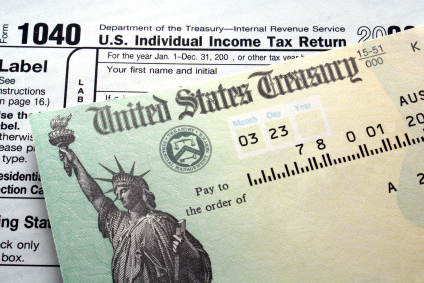It’s never fun paying taxes, but the good news is that many Americans will be receiving a bigger refund from Uncle Sam this year.
Of course, it’s tempting to go out and spend what seems like “found” money on a vacation or luxury item. Yet saving or investing that refund might be the wiser option.
About three out of four filers typically get refunds, and last year taxpayers received an average refund of $2,755, according to the IRS.
“Individual tax refunds are up 9% over last year and look set to break all-time records. As of the end of week 13 in 2014, Americans have received an incremental $17.6 billion back from the U.S. government over last year,” according to a note from ConvergEx Group.
Some other data points from ConvergEx:
-
Where that money goes is hard to track – we assume taxpayers use half for debt pay down and savings. The other half likely gets spent.
-
In fiscal 2013, the IRS collected over $2,8 trillion dollars from American consumers and businesses.
-
In Fiscal 2013, the IRS processed 146 million individual tax returns and issued 118.5 million refunds.This year, the IRS is quoting refunds levels closer to $3,000, although that includes all types of returns. For many American households, a $3,000 direct deposit is the equivalent of two week’s pay or more.
-
Refunds got off to a slow start in 2014 (for the 2013 tax year), but as of last Friday they were 9.2% higher than the same 13 week period in 2013.That equates to $17.6 billion of incremental payments to taxpayers.
-
The total amount paid out in refunds breached the $200 billion mark in Week 12, and this year’s refunds look to set all-time records in terms of total payments. We’ve included a chart with the annual run rates by week from 2005 to 2014 after this note, along with some other exhibits.
-
When compared to the average amount of IRS refunds since 2005, the scale of 2014’s incremental payments is more pronounced.The average of 2005 – 2013 refund payments is $180 billion, or $20 billion less than the money already distributed this year.
The positive takeaway is that many Americans will be receiving fatter tax refund checks in the mail this year.
It might be a good idea to put that money to work rather than spending it. How? Consider using your refund to pay down debt, boost savings, augment your emergency fund or invest for retirement.
Charles Sizemore, who manages the Dividend Growth portfolio on Covestor, recently discussed the benefits of putting refunds in a traditional or Roth IRA.
“With wage growth being stagnant over the past decade, saving money can be something of a challenge,” he said in a MainStreet report. “However, $3000 placed into a traditional IRA is worth an immediate $750 in tax savings in the 25% tax bracket.”
Photo credit: DRivers@WorldLaw via Flickr Creative Commons.
DISCLAIMER: The information contained in this article is general in nature and not intended as specific advice. Neither Covestor Limited nor its representatives are engaged in rendering tax, accounting or legal advice. A qualified professional should be consulted regarding the effect of such considerations on the matters covered in this article.




